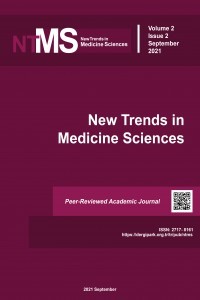Vestibular Evoked Myogenic Potential Abnormalities in Early and Late Stage Parkinson Patients
Vestibular Evoked Myogenic Potential Abnormalities in Early and Late Stage Parkinson Patients
ABSTRACT
Aim: Loss of balance can be seen in idiopathic Parkinson's disease (IPD) There are only a few studies in the literature in which brainstem involvement in IPD has been researched with neurophysiological tests such as vestibular evoked myogenic potential (VEMP). In this study, it was investigated whether there is a difference in the results of VEMP testing in early or late stage of IPD.
Material and method: The IPD cases were classified as early stage and late stage according to the Hoehn-Yahr scale. The presence of a positive wave with a latency of P13 and a negative wave with a latency of N23 was investigated as the first reflex response The latencies of these potentials and the absolute amplitude of the P13-N23 component were measured. The VEMP results of the patients with early and late stage IPD were compared with those of the control group.
Results: The right P13 latency mean value in the late stage patient group was significantly prolonged than in the early stage patient group and the control group. The right P13-N23 amplitude mean value of the late and early stage patient groups was significantly smaller than that of the control group (p
Keywords:
c VEMP, neurophysiology, brainstem early stage Parkinson’s disease, late stage Parkinson’s disease, Parkinson’s disease,
___
- 1. Braak H, Tredici KD, Rüb U, Ros VA, Steur EJ, Braak E. Staging of brain pathology related to sporadic Parkinson's disease. Neurobiology of Aging. 2003; 24(2):197-211.
- 2. Braak H , Müller CM, Rüb U, Ackermann H, Bratzke H, de Vos RID, Tredici KD. Pathology associated with sporadic Parkinson's disease--where does it end? J Neural Transm Suppl. 2006;(70):89-97.
- 3. Braak H , Ghebremedhin E, Rüb U, Bratzke H, Tredici KD. Stages in the development of Parkinson's disease-related pathology. Cell and Tissue Research, 2004. 318(1): p. 121-134.
- 4. Elibol B. Hareket Bozuklukları. Ankara: Rotatıp Kitabevi, 2011, 101-111.
- 5. Truong DD, Wolters EC, Recognition and Management of Parkinson's Disease during the Premotor (Prodromal) Phase, Expert Rev Neurother. 2009;9(6):847-857.
- 6. Smith PF, Vestibular Functions and Parkinson's Disease, Front Neurol. 2018; 9: 1085.
- 7. Heide G , Luft B, Franke J, Schmidt P, Witte OW, Axer H. Brainstem representation of vestibular evoked myogenic potentials. Clinical Neurophysiology 121 (2010) 1102-1108.
- 8. Pollak L, Prohorov T, Kushnir M, Rabey M. Vestibulocervical reflexes in idiopathic Parkinson disease. Clinical Neurophysiology 2009;39:235ó240.
- 9. Takegosh H, Murofushi T. Vestibular evoked myogenic potentials in patients with spinocerebellar degeneration. Acta Otolaryngol 2000;120:821-4.
- 10.Carpinelli S, Valko PO, Waldvogel D, Buffone E, Baumann CR, Straumann D, et all. Distinct Vestibular Evoked Myogenic Potentials in Patients With Parkinson Disease and Progressive Supranuclear Palsy, Front Neurol. 2020; 11: 598763. Published online 2021 Feb12. doi: 10.3389/fneur.2020.598763.
- 11. Venhovens J, Meulstee J, Bloem BR, Verhagen WIM. Neurovestibular Dysfunction and Falls in Parkinson's Disease and Atypical Parkinsonism: A Prospective 1 Year Follow-Up Study. Front Neurol. 2020 ;11:580285. doi: 10.3389/fneur.2020.580285.
- 12. Ajay KV, Brainstem Evoked Potentials in the Idiopathic Parkinson's Disease (PD) Ann Indian Acad Neurol. 2021 Mar-Apr; 24(2): 128–129. Published online 2021 Apr 5. doi: 10.4103/aian.AIAN_1254_20.
- 13. Park JH, Kang SY. Dizziness in Parkinson's disease patients is associated with vestibular function. Sci Rep. 2021 Sep 23;11(1):18976. doi: 10.1038/s41598-021-98540-5.
- 14.de Natale ER, Ginatempo F, Paulus KS, Pes GM, Manca A, Tolu E, et all. Abnormalities of vestibular-evoked myogenic potentials in idiopathic Parkinson's disease are associated with clinical evidence of brainstem involvement. Neurol Sci. 2015 Jun;36(6):995-1001. doi: 10.1007/s10072-014-2054-4.
- 15. Scarpa A, Cassandro C, Vitale C, Ralli M, Policastro A, Barone P,et all. A comparison of auditory and vestibular dysfunction in Parkinson's disease and Multiple System Atrophy. Parkinsonism Relat Disord. 2020 Feb;71:51-57. doi: 10.1016/j.parkreldis.2020.01.018.
- 16. Ampar N, Mehta A, Mahale RR, Javali M, Pradeep R, Acharya P,et all. Electrophysiological Evaluation of Audiovestibular Pathway Dysfunction in Parkinson's Disease and Its Correlates: A Case Control Study. Ann Indian Acad Neurol. 2021;24(4):531-535. Doi:10.4103/aian.AIAN_1011_20.
- 17. Hawkins KE, Paul SS, Chiarovano E, Curthoys IS. Using virtual reality to assess vestibulo-visual interaction in people with Parkinson's disease compared to healthy controls. Exp Brain Res. 2021 ;239(12):3553-3564. doi: 10.1007/s00221-021-06219-0.
- 18. Hawkins KE, Chiarovano E, Paul SS, MacDougall HG, Curthoys IS. Static and dynamic otolith reflex function in people with Parkinson's disease. Eur Arch Otorhinolaryngol. 2021 Jun;278(6):2057-2065. doi: 10.1007/s00405-020-06446-1.
- 19. de Natale ER, Ginatempo F, Paulus KS, Manca A, Mercante B, Pes GM, et all. Paired neurophysiological and clinical study of the brainstem at different stages of Parkinson's Disease. Clin Neurophysiol. 2015 Oct;126(10):1871-8. doi: 10.1016/j.clinph.2014.12.017.
- 20. Shalash AS, Hassan DM, Elrassas HH, Salama MM, Méndez-Hernández E, Salas-Pacheco JM, et all. Auditory and Vestibular-Evoked Potentials Correlate with Motor and Non-Motor Features of Parkinson's Disease. Front Neurol. 2017 Feb 27;8:55. doi: 10.3389/fneur.2017.00055.
- ISSN: 2717-8161
- Başlangıç: 2020
- Yayıncı: Fazile Nur Ekinci Akdemir
Sayıdaki Diğer Makaleler
Behçet VARIŞLI, Canan AKMAN, Sinan YILDIRIM, Kenan ATAÇ, Okan ÇAKIR
Brucellosis, a Rare Cause of Muscle and Joint Pain Following Covid-19 Treatment in Endemic Regions
Ahmet Veli ŞANİBAŞ, Fatma ÇAKMAK, İdris BAYDAR, Doğan Nasır BİNİCİ
Özgür ÇELEBİ, Sümeyye BAŞER, Mustafa Can GÜLER, Demet ÇELEBİ, Selahattin ÇELEBİ
The Effect of Long-Term Lithium Use on Renal Functions in Patients with Bipolar Disorder
Batuhan AYIK, Sibel ÇAKIR, Halil YAZICI, Rümeysa TAŞDELEN
Vestibular Evoked Myogenic Potential Abnormalities in Early and Late Stage Parkinson Patients
